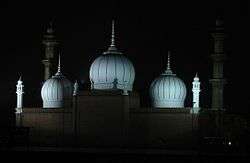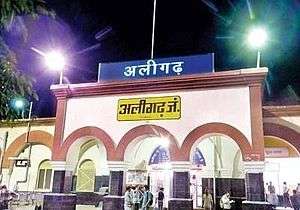Aligarh, Uttar Pradesh
| Aligarh अलीगढ़ علی گڑھ | |
|---|---|
| Metropolitan City | |
|
| |
 Aligarh Location in Uttar Pradesh, India | |
| Coordinates: 27°53′N 78°05′E / 27.88°N 78.08°ECoordinates: 27°53′N 78°05′E / 27.88°N 78.08°E | |
| Country | India |
| State | Uttar Pradesh |
| Division | Aligarh |
| District | Aligarh |
| Founded by | koil-Dor Rajputs; Aligarh-Nafaz Khan |
| Government | |
| • Body | Aligarh Nagar Nigam |
| • Mayor | Shakuntala Bharti |
| Elevation | 178 m (584 ft) |
| Population (2015)[1] | |
| • Total | 1,274,408 |
| • Rank | 55 |
| Languages | |
| • Official | Hindi, Urdu |
| Time zone | IST (UTC+5:30) |
| PIN | 202001,202002 |
| Telephone code | 0571 |
| Vehicle registration | UP-81 |
| Website |
aligarh |
Aligarh (; formerly Allygurh) is a city in the Northern Indian state of Uttar Pradesh and the administrative headquarters of the Aligarh district. It lies 126 miles (203 km)) northwest of Kanpur and is approximately 90 miles (140 km) southeast of the capital, New Delhi. Notable as the seat of Aligarh Muslim University, Aligarh is one of the largest cities in Uttar Pradesh as well as the 55th largest city in India.[2]
History
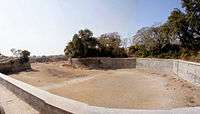
Before the 18th century, Aligarh was known as Kol. The history of the district up until the 12th century is obscure.[3]
According to an 1875 gazetteer written by Edwin T. Atkinson, the name Kol was given to the city by Balarama, who slew the great Asura (demon) Kol there and, with the assistance of the Ahirs, subdued this part of the doab.[4] In another account, Atkinson points out a "legend" that Kol was founded by the Dor tribe of Rajputs in 372. This is further confirmed by an old fort, the ruined Dor fortress, which lies at the city centre.
Some time before the Muslim invasion, Kol was held by the Dor Rajputs. At the time of Mahmud of Ghazni, the chief of the Dors was Hardatta of Baran.[4] Statues of Buddha and other Buddhist remains have been found in excavations where the citadel of Koil stood, indicating a Buddhist influence. Hindu remains indicate that the citadel probably had a Hindu temple after the Buddhist temple.[4]
In 1194, Qutb-ud-din Aibak marched from Delhi to Kol, "one of the most celebrated fortresses of Hind".[4] Qutb-ud-din Aibak appointed Hisam-ud-din Ulbak as the first Muslim governor of Koil.[4]
Koil is mentioned in Ibn Battuta's Rihla, when Ibn Battuta along with 15 ambassadors representing Ukhaantu Khan, emperor of the Mongol Chinese Yuan dynasty, travelled to Kol city en route to the coast at Cambay (in Gujarat) in 1341.[5] According to Battuta, it would appear that the district was then in a very disturbed state since the escort of the Emperor's embassy had to assist in relieving Jalali from an attacking body of Hindus and lost an officer in the fight. Ibn Batuta calls Kol "a fine town surrounded by mango groves". From these same groves the environs of Kol would appear to have acquired the name Sabzabad or "the green country".[4]
In the reign of Akbar, Kol was made a Sirkar and included the dasturs of Marahra, Kol ba Haveli, Thana Farida and Akbarabad.[4] Akbar and Jahangir visited Kol on hunting expeditions. Jahangir clearly mentions the forest of Kol, where he killed wolves.[3]
During the time of Ibrahim Lodhi, Muhammad, son of 'Umar, was the governor of Kol. He built a fort at Kol and named the city Muhammadgarh, after himself, in 1524–25. Sabit Khan, who was then the governor of this region, of Farrukh Siyar and Muhammad Shah, rebuilt the old Lodhi fort and named the town after himself: Sabitgarh.
The Jat ruler, Surajmal, with help from Jai Singh of Jaipur and the Muslim army, occupied the fort of Koil. Koil was renamed Ramgarh and finally, when a Shia commander, Najaf Khan, captured it, he gave it its present name of Aligarh. Aligarh Fort (also called Aligarh Qila), as it stands today, was built by French engineers under the command of French officers Benoît de Boigne and Perron.[3]
Battle of Aligarh (1803)
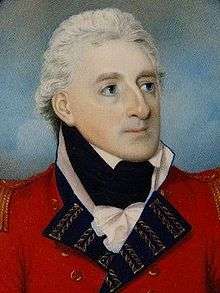
The Battle of Aligarh was fought on 1 September 1803 during the Second Anglo-Maratha War (1803–1805) at Aligarh Fort. The British 76th Regiment, now known as the Duke of Wellington's Regiment besieged the fort, which was under the control of the French officer Perron, and established British rule. In 1804, the Aligarh district was formed by the union of the second, third and fourth British divisions with the addition of Anupshahr from Muradabad and Sikandra Rao from Etawa. On 1 August 1804, Claude Russell was appointed the first Collector of the new district.[6] Shri Budhsen upadhyay was a famous and prominent freedom fighter iglas block.
Administration
Aligarh district is divided into five tehsils, namely Kol Tehsil, Khair Tehsil, Atrauli, Gabhana and Iglas. These tehsils are further divided into 12 blocks.
The city is administered by Nagar Nigam Aligarh (Municipal Corporation), which is responsible for performing civic administrative functions administered by Mayor and Municipal Commissioner (PCS Officer). Infrastructure development of the city is looked after by the Aligarh Development Authority (ADA) administered by Divisional Commissioner (Chairman) and Vice-Chairman (PCS Officer).
Aligarh is the headquarters of Aligarh Police Range and Aligarh Division. A DIG looks after Aligarh for legal condition and law; a Commissioner looks for four district of Aligarh Division(Aligarh, Etah, Hathras, Kasganj).
Geography
Location
Aligarh is located at the coordinates 27°53′N 78°05′E / 27.88°N 78.08°E.[7] It has an elevation of approximately 178 metres (587 feet). The city is in the middle portion of the doab, the land between the Ganges and the Yamuna rivers. The G.T. Road passes through. It is 134 km from capital of India via NH-91.
Climate
Aligarh has a monsoon-influenced humid subtropical climate, typical of north-central India. Summers start in April and are hot with temperatures peaking in May. The average temperature range is 28–38 °C (82–100 °F). The monsoon season starts in late June, continuing till early October, bringing high humidity. Aligarh gets most of its annual rainfall of 800 millimetres (31 in) during these months. Temperatures then decrease, and winter sets in December, and continues till February. Temperatures range between 5–11 °C (41–52 °F). Winters in Aligarh are generally mild, but 2011–12 experienced the lowest temperature of 1 °C. The fog and cold snaps are extreme.
| Climate data for Aligarh | |||||||||||||
|---|---|---|---|---|---|---|---|---|---|---|---|---|---|
| Month | Jan | Feb | Mar | Apr | May | Jun | Jul | Aug | Sep | Oct | Nov | Dec | Year |
| Record high °C (°F) | 30.7 (87.3) |
33.3 (91.9) |
41.7 (107.1) |
44.8 (112.6) |
47.5 (117.5) |
46.7 (116.1) |
44.5 (112.1) |
42.1 (107.8) |
40.2 (104.4) |
41.7 (107.1) |
36.1 (97) |
32.8 (91) |
47.5 (117.5) |
| Average high °C (°F) | 20.6 (69.1) |
23.6 (74.5) |
30.0 (86) |
36.8 (98.2) |
40.1 (104.2) |
39.3 (102.7) |
34.6 (94.3) |
33.2 (91.8) |
33.8 (92.8) |
33.0 (91.4) |
28.3 (82.9) |
22.5 (72.5) |
31.3 (88.3) |
| Average low °C (°F) | 7.4 (45.3) |
9.5 (49.1) |
14.1 (57.4) |
20.1 (68.2) |
24.5 (76.1) |
26.6 (79.9) |
26.0 (78.8) |
25.4 (77.7) |
23.8 (74.8) |
18.8 (65.8) |
12.9 (55.2) |
8.5 (47.3) |
18.1 (64.6) |
| Record low °C (°F) | 0.0 (32) |
1.7 (35.1) |
3.9 (39) |
10.9 (51.6) |
15.5 (59.9) |
18.6 (65.5) |
19.9 (67.8) |
19.9 (67.8) |
14.8 (58.6) |
11.0 (51.8) |
2.9 (37.2) |
1.2 (34.2) |
0.0 (32) |
| Average precipitation mm (inches) | 15.2 (0.598) |
13.9 (0.547) |
8.5 (0.335) |
8.8 (0.346) |
21.0 (0.827) |
68.5 (2.697) |
217.7 (8.571) |
247.4 (9.74) |
104.1 (4.098) |
31.4 (1.236) |
4.2 (0.165) |
11.0 (0.433) |
751.8 (29.598) |
| Average rainy days | 1.5 | 1.4 | 1.0 | 0.9 | 2.2 | 4.1 | 10.2 | 11.6 | 5.2 | 1.4 | 0.5 | 0.8 | 40.7 |
| Source: India Meteorological Department (record high and low up to 2010)[8][9] | |||||||||||||
Demographics
The provisional data of 2011 census showed the Aligarh urban area with a population of 12,74,408. Males outnumber females 4,61,772 to 4,12,636 (2011). The literacy rate was 70.54 per cent.[11]
Economy
The city is an agricultural trade centre.[12] Agricultural product processing and manufacturing are important.[13]
Aligarh is an important business centre of Uttar Pradesh and is most famous for its lock industry. Aligarh locks are exported across the world. In 1870, Johnson & Co. was the first English lock firm in Aligarh. In 1890, the company initiated production of locks on a small scale here.[14]
Aligarh is famous for brass hardware and sculpture. Today, the city holds thousands of manufacturers, exporters and suppliers involved in the brass, bronze, iron and aluminium industries.
Aligarh is a big centre of zinc die casting. There are thousands of pneumatic hot chamber die casting machines. But many exporters have adopted latest technology and have installed fully automatic, computerised hot chamber machines. Indian Diecasting Industries at Sasni Gate Area is the most renowned manufacturer in this line and they are capable of meeting international quality norms.
Harduaganj Thermal Power Station (also referred as Kasimpur Power House) is 15 km from the city. Narora Atomic Power Station is located 50 km from Aligarh. Despite its proximity to two large power stations, frequent power cuts are normal in Aligarh.
Aligarh hosts Heinz-sauce manufacturing unit in Manzurgarhi, Satha sugar factory on the Aligarh-Kasimpur Power House route and a cement factory of UltraTech Cement company. Indian Oil Boteling Plant exits at Andla in Khair. Wave Distallery (Kingfisher bear) located at Atrauli in Aligarh.
Hicks thermometer has manufacturing in Industrial Estate, Aligarh
SAC Entertainment[15] an event and artist management company that is famous for managing college and school festivals has its registered office in Aligarh[16]
Development
Aligarh is the 55th fastest-growing city in India. Following major development projects are under construction in City.
- Govt. Homeopathic Medical College and Hospital, Chherat
- Super Speciality Trauma Center at AMU
- Sports University at Khair Road
- ISKCON Temple at Harduaganj
- World class Shooting Range at Chherat
- Astro Turf Hockey Stadium in AMU
- NH-93 Kathmandu-Jamalpur Crossing 4 Lane work (Completed Except flyover at Jamalpur Crossing)
- Aligarh-Khair-Palwal 4 Lane highway work
- Aligarh-Moradabad 4 Lane highway work
- World Class Golf Corse at AMU Aligarh
- 5 Star Country Inn Hotel near to Aligarh Junction(Will be ready in 2017)
- DPS World School, Khair
- A bypass railway line for Goods train
Education
There are numerous School and colleges in Aligarh for education. Aligarh Muslim University is a leading central university it provides education in various field such as medical and engineering Some of the Engineering colleges in Aligarh are
- Maharishi vidya mandir, Agra road Aligarh.
- Blue Bird Senior Secondary School, Aligarh.
- Institute Of Information Management & Technology(IIMT) Aligarh
- ACN college of engineering and management studies
- Aligarh College of Engineering & Technology
- Shivdan Singh Institute of Engineering and Management
- Vivekanand College of Technology and Management
- Institute of Technology and Management, Aligarh
- Gagan College Of Management & Technology
- Shri Sher Singh Nayak inter college, Raipur khas,
- Shri Budhsen Public School ,Iglas,Aligarh
Locations
Cultural landmarks
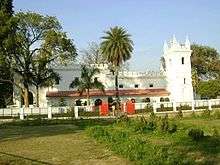
Aligarh has several popular landmarks. Most notable few of them are Aligarh fort, Another one is Khereshwar Temple which is the Birth Place of Swami Shri HARIDAS JI, Teerthdham Mangalayatan Mandir and Dor fortress (1524), which is now in ruins, lies at the city's centre; its site is in the area now called Upper Kot and is occupied by an 18th-century mosque.
The Annual Cultural Exhibition, popularly known as Numaish, is held at the exhibition ground in January and February. The cultural shows takes place at 3 grand stages(Kohinoor, Krishnanjali, Muktakash). In all more than 150 stage events featuring artist from across the India takes place during a period of 28 days. In 2015, for the first time the major cultural programs of Numaish was managed by an Aligarh-based firm SAC Entertainment at Kohinoor stage.[17]
A. C. Bhaktivedanta Swami Prabhupada visited Aligarh in October 1976
founded by Varshney community of Aligarh.
Historical places
- Shekha Jheel, Bird Sanctuary
- Maulana Azad Library(AMU campus) (Estd 1875)
- Clock Tower known in Hindi Ghanta Ghar
- Aligarh Fort, known as Aligarh Quila
- Achal Taal, Historical Pond
- Dharnidhar Sarovar, Beswan, Tapobhumi of Vishwamitra
- Jama Masjid (Mosque) (Const 1727)
Places of worship
Khereshwar Temple which is the Birth Place of Swami Shri HARIDAS JI, "Sai Mandir" at Sarsol on G.T. Road. Many old Hindu temples in the city are near Achal Taal (opposite Dharma Samaj College). There are four key temples at four corners of the Achal Taal; all the four temples are Hindu Siddh Peeth. The Tika Ram mandir at centre point is also a renowned temple of the city. Khereshwar Dham is known for an ancient Lord Shiv temple and situated at Haridaspur, Aligarh (3 km from Aligarh).It is one of the famous temple of the city.
Another landmark is Sir Syed Masjid in Aligarh Muslim University's campus.
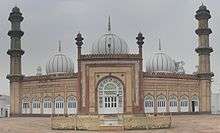
The city contains tombs of Muslim saints Hazrat Shah Jamal (R.A) at Shah Jamal Area Barchi Bahadur was the one of the Descendants of Shah Jamal.[18] Aligarh has a very renowned tomb, Baba Barchi Bahadur, at Kath Pula. Another old Jain temple with fresco painted ceilings is located behind Khirni Gate Police Chowky at Agra Road in the main City.
A famous Jainism Teerth Dhaam "Mangalayatan Teerth Dhaam" was built at Agra Road.
Aligarh Muslim University
Aligarh Muslim University (AMU) is one of the oldest central university. It was established by Sir Syed Ahmed Khan as Madrasatul Uloom Musalmanan-e-Hind, In 1875–78 which later became Mohammedan Anglo-Oriental College (MAO College). It was designed to train Muslims for government services in India and prepare them for advanced training in British universities. The Mohammedan Anglo-Oriental College became Aligarh Muslim University in 1920. It is famous for its Law, Medical and Engineering College.
Media
Aligarh currently has 7 FM Radio stations:
- 92.7 MHz Big FM
- 94.9 MHz Fever FM
- 101.3 MHz All India Radio,
- 90.8 FM Alive Aligarh's first community radio station-Barahdwari
- 90.4 Mangalvani Manglaytan University community radio station
2 new FM stations coming soon--
- 104.6 MHz Tadka FM
- 94.1 MHz Renderlive Films & Entertainment Pvt. Ltd.
- Hindi Newspapers include Amar Ujala,[19] Dainik Jagran, Hindustan Dainik, Avadhnama, Punjab Kesari, Action India, Data Sandesh, Sach Kahoo, DNSP NEWS etc.
Organisations
Social organisations in Aligarh city, include
- Rotary Club
- Rashtriya Swayamsevak Sangh, Dwarikapuri, Agra Road
- Vishwa Hindu Parishad, G.T. Road
- SIMMI, a banned Islamic student organisation (formed in April,1977)
- Chetana Jagrati Punj
Film festival
International short film festival Filmsaaz is being held since 2008 by Aligarh Muslim University.
Culture, folk music and cinema
Various styles of music and art in folk songs of North India's Braj region include:
Transport
By rail
Aligarh Junction railway station is the primary station for Aligarh city and is a major stop on the Delhi-Kolkata route.It is a A-Class railway station.It is one of the oldest railway station of this route. It connects Aligarh to the states of West Bengal, Odisha, Bihar, Jharkhand, north-east and most of Uttar Pradesh, and important cities such as New Delhi, Mumbai, Kolkata, Bhopal, Indore, Jammu, Gwalior, Lucknow, Jhansi, Puri, Kanpur, Agra and Varanasi. Aligarh railway station handles over 136 trains daily (in both directions) and serves around 204,000 passengers everyday. Aligarh has one Branch Railway Line to Bareily.
Aligarh City has following railway stations:
- Aligarh Junction: a A-Class Railway Station
- Somna (Gabhana) railway station
- Mahrawal railway station
- Kalua railway station
- Daudkhan railway station
- Mandrak railway station
- Harduaganj railway station(Satha, near Kasimpur Power House)
- Manjoorgarhi railway station (Chherat)
By road
Aligarh is 140 km from New Delhi. It is one of the Division of UPSRTC. Uttar Pradesh State Road Transport Corporation (UPSRTC) buses serve cities all over the state and cities in Uttarakhand, Rajasthan, Madhya Pradesh and Haryana.
Aligarh City has two UPSRTC bus stations:
- Aligarh Depot bus station (It is under renovation).
- Masoodabad (Budh Vihar) Depot bus station
- ISBT proposed at Sarsaul.
There are buses plying from Aligarh to Delhi at frequent intervals via
1) Khair, Tappal, Palval, faridabad, delhi. the route is under construction between Khair and Palval and should be strictly avoided for cars. No toll charges.
2) Khair, Tappal, Yamuna expressway, G Noida, Noida, Delhi, Gurgaon. - Best and recommended Route for Delhi, Noida, Gurgaon. Toll Charges are 120 rs between aligarh and delhi.
3) Old GT Road, Ghaziabad, Delhi. NH 91, it is a four lane highway (Toll road).Toll charges 190 Rs.
Following Highways are connected to Aligarh.
- National Highway 91- It connects Kolkata to National capital New Delhi. Ghaziabad-Aligarh section is 4 Lane Highway.
- National Highway 93- It connects Moradabad to Taj Nagri Agra via Aligarh. Aligarh-Agra section is constructed as Brijbhoomi Expressway.
- Yamuna Expressway- It is 6 Lane Expressway Noida-Agra crossing at Tappal in Khair Tehsil from where Khair City is 30 km.
Aligarh City has Mahanagar Bus Service (City Bus Service) which provides local transport to Aligarh.
- Route-1 J N Medical-Uperkot
- Route-2 Gandhi Park-Sarsaul
- Route-3 Ghantarbagh-Quarsi
- Route-4 Gandhi Park-Boner
- Route-5 Etah Chungi-Collectrate
By air
The nearest international airport from Aligarh is Indira Gandhi International Airport, New Delhi. It is 140 km from Aligarh.
Aligarh Airport is in under construction, it is in Dhanipur on NH 91. Dhanipur Air Strip is used as Flying Club. The Government of Uttar Pradesh signed a MoU with the Airports Authority of India (AAI) in February 2014 for the development of the airport.
Notable personalities
Educationalists

- Sir Syed Ahmad Khan founder of Aligarh Muslim University
- Sir Ziauddin Ahmed, Mathematician, M.L.A. (Central), Longest term Vice-Chancellor and pillar of Aligarh Muslim University Movement. He established several institution including J.N. Medical College.
- Masud Husain Khan, Father of Urdu-Linguistics, and 5th Vice-Chancellor of Jamia Millia Islamia.
Spiritualists
- Swami Haridas, spiritual poet and classical musician of Vrinaban, Mathura. born at Khereswar Dham, Khair
Writers, poets and publishers
- Gopaldas Neeraj, poet, recipient of Padma Bhushan
- Jainendra Kumar, famous Hindi writer
- Akhlaq Mohammed Khan, pen name Shaharyar, Urdu poet, Bollywood lyricist and served as Professor at Aligarh Muslim University
- Maitreyi Pushpa, Notable Hindi fiction writer
- Saghar Nizami , Urdu Poet
- Qurratulain Hyder, a Padma Bhushan, Urdu novelist, writer and journalist
- Prem Kishore Patakha, Hindi Humorous Poet
- Munshi Newal Kishore famous book publisher
- A.R. Akela, Dalit author and publisher, owner of "Anand Sahitya Sadan"
- Syed Amin Ashraf, eminent Urdu poet and professor of English at AMU
Historians
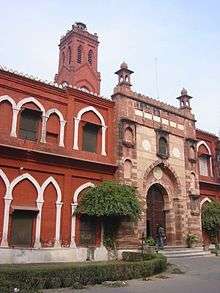
- Mohammad Habib (1895–1971), noted Indian historian and served as Professor Emeritus at Aligarh Muslim University
- Irfan Habib, eminent Indian historian and Professor Emeritus at Aligarh Muslim University
Freedom Fighters
- Captain Abbas Ali, captain in the Indian National Army led by Netaji Subhash Chandra BoseThakur Nathan Singh
Film actors
- Bharat Bhushan, Bollywood actor, scriptwriter and producer
- Chandrachur Singh, Bollywood actor
- Shad Khan, anchor, actor and director
- Salim Shah, Indian television and film actor
- Hasan Zaidi, Indian television actor
- Aadesh Chaudhary, Indian television actor
- Nitin Chauhaan, Indian television actor
- Ravindra Jain, Bollywood music director
- Basharat Peer, Indian journalist and scriptwriter, written script for feature film Haider(2014)
- Zarina
Sports persons
- Annu Raj Singh, international shooter
- Zafar Iqbal, Former Hockey Captain of India
- Yuvraj Valmiki, hockey player in Indian team
- Piyush Chawla, Indian Cricketer
Politicians
- Thakur Dalveer Singh, MLA from Baruli vidhansabha constituency
- Kalyan Singh, Ex. CM of Uttar Pradesh and Current Governor of Rajsthan
- Zafar Alam, Current MLA
- Satish Kumar Gautam, current MP from, Aligarh (Lok Sabha constituency)
- Sheela Gautam, Ex MP & owner of Sleepwell
- Jamal Khwaja, Ex MP
- Bijendra Singh, Ex MP
- Thakur Jaiveer Singh, Ex MLA (Now MLC)
- Chaudhary Sunil Singh, Ex MLC
- Roohi Zuberi
- Rachit Pammi
Medical professionals
- Hakim Syed Zillur Rahman, Unani physician and author
- Syed Ziaur Rahman, Unani physician and author
- Khwaja Abdul Hamied, Pharmacist, founder of Cipla(a pharmaceutical company)
Social activists
- Jai Kishan Das, close associate of Sir Syed Ahmad Khan
- Rajiv Dixit, Indian social activist.
- Roohi Zuberi Advocate, Social worker, political activist.
References
- ↑ "Aligarh City Population Census 2011 | Uttar Pradesh". Census2011.co.in. Retrieved 2015-11-06.
- ↑ "Top cities of India by population, Census 2011". Census2011.co.in. Retrieved 18 April 2014.
- 1 2 3 "Histor11". Aligarhdirectory.com. Retrieved 2015-07-29.
- 1 2 3 4 5 6 7 Edwin T. Atkinson (1875). Descriptive and Historical Account of the Aligarh District. p. 484. Retrieved 13 October 2011.
- ↑ The Adventures of Ibn Battuta, by Ross E. Dunn, p. 215
- ↑ Edwin T. Atkinson (1875). Descriptive and Historical Account of the Aligarh District. p. 348. Retrieved 13 October 2011.
- ↑ "Falling Rain Genomics, Inc – Aligarh". Fallingrain.com. Retrieved 13 October 2011.
- ↑ "Aligarh Climatological Table Period: 1971–2000". India Meteorological Department. Retrieved April 15, 2015.
- ↑ "Ever recorded Maximum and minimum temperatures up to 2010" (PDF). India Meteorological Department. Archived (PDF) from the original on 21 May 2013. Retrieved April 15, 2015.
- ↑ 2011 census of India: Datasheet
- ↑ "Urban Agglomerations/Cities having population 1 lakh and above" (PDF). Provisional Population Totals, Census of India 2011. Retrieved 7 July 2012.
- ↑ "India9.com". India9.com. 7 June 2005. Retrieved 13 October 2011.
- ↑ "Britannica". Britannica. Retrieved 13 October 2011.
- ↑ Pawan JainPawan Jain (3 June 2003). "Times of India". Timesofindia.indiatimes.com. Retrieved 13 October 2011.
- ↑ "SAC Entertainment". Sacentertainment.in. Retrieved 2015-07-29.
- ↑ "Google Maps". Google.co.in. Retrieved 2015-07-29.
- ↑ "Dainik Jagran". Epaper.jagran.com. 29 Jan 2015. Retrieved 2015-07-29.
- ↑ Hoiberg, Dale; Ramchandani, Indu (2000). Students' Britannica India. New Delhi: Encyclopaedia Britannica (India). ISBN 0852297602. OCLC 45086947.
- ↑ "Hindi Newspapers". Amar Ujala. Retrieved 19 July 2016.
Further reading
- Aligarh in My Days (Interviews of former Vice-Chancellors of Aligarh Muslim University), Ed. Syed Ziaur Rahman, Non-Resident Students' Centre, Aligarh Muslim University, Aligarh, 1997.
- Atkinson, Edward (2010) [1875]. Descriptive And Historical Account of the Aligarh District. Nabu Press. ISBN 1-147-42719-4.
list of Celebrities upcoming in 2016 MangalBazaar Hindi Novel
